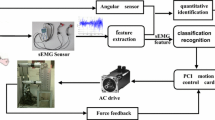Abstract
Surface electromyography (SEMG) is an important tool for analyzing gait movements. Effective segmentation of electromyography (EMG) start/end points is an important step in the analysis of EMG signals. This paper presents a SEMG segmentation algorithm based on signal envelope and integral electromyography. Compared with manual segmentation, the coincidence rate is more than 90%. There is no statistical difference in the characteristic parameters of EMG signals calculated from the start/end points obtained by the segmentation algorithm and the manual segmentation method (P > 0.05). Based on this segmentation algorithm, quantitative analysis and comparison of the force situation of the iliopsoas, musculus gracilis, soleus and tibialis anterior muscles during the complete gait cycle are performed. This study lays the foundation for the application of surface electromyography in the field of rehabilitation analysis and control, such as rehabilitation training and rehabilitation robots.










Similar content being viewed by others
References
Patla, A.E.: Effects of walking on various inclines on EMG patterns of lower limb muscles in humans. Hum. Mov. Sci. 5(4), 345–357 (1986)
Chen, Yang, Zhao, Xingang, Han, Jianda: Hierarchical projection regression for online estimation of elbow joint angle using EMG signals. Neural Comput. Appl. 23(3–4), 1129–1138 (2013)
Cha, Y.-J., Kim, J.-D., Choi, Y.-R., et al.: Effects of gait training with auditory feedback on walking and balancing ability in adults after hemiplegic stroke: a preliminary, randomized, controlled study. Int. J. Rehabil. Res. 41, 239–243 (2018)
Li, Yantao, Zhou, Gang, Graham, Daniel, Holtzhauer, Andrew: Towards an EEG-based brain-computer interface for online robot control. Multimed. Tools Appl. 75(13), 7999–8017 (2016)
De Luca, A., Vernetti, H., Capra, C., et al.: Recovery and compensation after robotic assisted gait training in chronic stroke survivors. Disabil. Rehabil. Assist. Technol. (2018). https://doi.org/10.1080/17483107.2018.1466926
Staudenmann, D., Roeleveld, K., Stegeman, D., et al.: Methodological aspects of SEMG recordings for force estimation—a tutorial and review. J. Electromyogr. Kinesiol. 20(3), 375–387 (2010)
Yoo, J.H., Nixon, M.S., Harris, C.J.: Extraction and description of moving human body by periodic motion analysis. In: Proceedings of ISCA 17th International Conference on Computers and Their Applications 2002, April 4–6, San Francisco, CA, pp. 110–113 (2002)
Song, H., Cho, S., You, K.J., et al.: Improving DOA estimation and preventing target split using automotive radar sensor arrays. IEICE Trans. Fundam. Electron. Commun. Comput. Sci. 101(3), 590–594 (2018)
Kubota, S., Nakata, Y., Eguchi, K., et al.: Feasibility of rehabilitation training with a newly developed wearable robot for patients with limited mobility. Arch. Phys. Med. Rehabil. 94(6), 1080–1087 (2013)
Costa, A., Itkonen, M., Yamasaki, H., et al.: A novel approach to the segmentation of sEMG data based on the activation and deactivation of muscle synergies during movement. IEEE Robot. Autom. Lett. PP(99), 1 (2018)
Lin, L., Jianhui, W., et al.: Improved automatic segmentation method of sEMG based on signals’ energy value. Comput. Sci. 40(6a), 188–191 (2013). (in Chinese)
Wang, J., Jin, X., et al.: sEMG signal analysis method and its application research. China Sport Sci Technol 36(8), 26–28 (2000). (in Chinese)
Piskorowski, J.: Time-efficient removal of power-line noise from EMG signals using IIR notch filters with non-zero initial conditions. Biocybern. Biomed. Eng. 33(3), 171–178 (2013)
Sayadi, O., Shamsollahi, M.B.: Multiadaptive bionic wavelet transform: application to ECG denoising and baseline wandering reduction. EURASIP J. Adv. Signal Process. 2007(1), 041274 (2007)
Barzilay, O., Wolf, A.: A fast implementation for EMG signal linear envelope computation. J. Electromyogr. Kinesiol. Off. J. Int. Soc. Electrophysiol. Kinesiol. 21(4), 678 (2011)
Gupta, R.: Analysis of Surface Electromyogram Signals Using Integrated Bispectrum. In: India international conference on information processing, pp. 1–5 (2016)
Albulbul, A.: Evaluating major electrode types for idle biological signal measurements for modern medical technology. Bioengineering 3(3), 20 (2016)
Qian, W.: Surface Electromyography Based Human Gait Analysis and Its Applications. University of Science and Technology of China, Hefei (2013). (in Chinese)
Jang, E.H., Chi, S.Y., Lee, J.Y., et al.: Surface electromyogram activities of upper and lower limb muscles during walking. Int. J. Psychophysiol. 81(3), 341 (2011)
Whittle, M.W.: Gait analysis: an introduction—3rd edition. Physiotherapy 77(11), 786 (2003)
Sabzevari, V.R., Jafari, A.H., Boostani, R.: Muscle synergy extraction during arm reaching movements at different speeds. Technol. Health Care Off. J. Eur. Soc. Eng. Med. 25(1), 123–136 (2016)
Acknowledgements
The project has been supported by the Special Fund for the Development of Shenzhen (China) Strategic New Industry (JCYJ20170818085946418) and the Shenzhen (China) Science and Technology Research and Development Fund (JCYJ20170306092000960).
Author information
Authors and Affiliations
Corresponding author
Rights and permissions
About this article
Cite this article
Wang, M., Wang, X., Peng, C. et al. Research on EMG segmentation algorithm and walking analysis based on signal envelope and integral electrical signal. Photon Netw Commun 37, 195–203 (2019). https://doi.org/10.1007/s11107-018-0809-1
Received:
Accepted:
Published:
Issue Date:
DOI: https://doi.org/10.1007/s11107-018-0809-1




